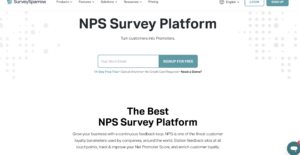NPS
How to Control and Reduce Churn using NPS?
Article written by Mathew Maniyamkott
Regular contributor to various magazines. Passionate about entrepreneurship, startups, marketing, and productivity.
13 min read
19 September 2025

1-Minute Summary
Customer churn can quietly hurt business growth, but using Net Promoter Score (NPS) helps identify and fix churn risks proactively. NPS segments customers into Promoters, Passives, and Detractors based on their likelihood to recommend your product.
By analyzing feedback from Detractors, businesses can uncover pain points and take corrective action—whether it's improving customer support, fixing product issues, or refining onboarding. Promoters, on the other hand, can be engaged for referrals and testimonials.
The blog emphasizes turning NPS into an ongoing feedback loop: collect responses regularly, close the loop by responding to issues quickly, and track improvements over time. Ultimately, using NPS smartly can boost customer satisfaction, loyalty, and retention.
Experiencing churn and looking to learn how to reduce churn using NPS?
For most businesses, especially SaaS businesses, customer churn is a big problem. There are a lot of challenges in keeping the customers stay in business with you.
There are options aplenty for your customers too which makes it all the more difficult to reduce churn. App churns impact the lifetime value of customers, impact user acquisition, impact marketing spending, and more.
What is Customer Churn?
Customer churn happens when someone decides to stop doing business with your company. And it's not just about losing that one sale—there’s a bigger cost involved. You lose future revenue, plus all the time and money you spent trying to win that customer in the first place.
In some cases, the customer might leave before you even break even on what it cost to acquire them. And as most businesses know, finding new customers is almost always harder—and more expensive—than keeping the ones you already have.
That’s why it’s so important to understand why customers leave and what you can do to keep them around. If you can answer those two questions, you’ll be in a much better position to reduce churn and build long-term customer relationships.
Why do customers churn?
- Low engagement. Customers might not be using the app as much as they wanted to. You need to track engagement. Know more about it using customer surveys. Net Promoter Score is one of the best ways to do it.
- Frequency of bugs in the app or performance issues. You can track this using the NPS survey at customer touchpoints.
- Bad UI/UX. Again, NPS is a metric that you can use to check this.
- Lack of customer support. NPS helps measure the effectiveness of the customer service team.
- Loss of key users. There are a handful of product evangelists who are interested in using your product. If they leave the company, you are at a high risk of churn.
- Awful onboarding process. NPS can help track its efficacy.
There are many more reasons for customer churn. But the point that we wanted to make was that NPS will help you unearth all the issues that you have that lead to customer churn by identifying those areas.
The Net Promoter Score is an index that ranges anywhere between -100 and +100 which measures the willingness of a customer to recommend your company’s products or services to people they know. It is used to find out the customer’s overall satisfaction with the product and the loyalty of the customer towards the brand.
The respondents, as we know, are divided into three categories namely Detractors, Passives, and Promoters.
The NPS calculation is based on subtracting the percentage of promoters and detractors.
Detractors are people who respond with anywhere from 0 to 6 and are expected to leave your business soon while Passives (those gave you 7 and 8) will stay for some time as they are moderately satisfied with your product but will leave you for a better one.
Your Promoters (scores of 9 and 10) are the ones who love your brand and it is expected that they will renew their subscription with you or buy more from you in the future.
What is so special about NPS is that it helps you identify the customers who are more likely to churn. Promoters are the least likely to churn while Passives and Detractors are at risk of leaving your business. But that’s not all. There are several other ways in which you can reduce churn using NPS.

Explore Deeper Customer Insights with SurveySparrow
A personalized walkthrough by our experts. No strings attached!
How to Reduce Churn Using NPS?
NPS results can really help control customer churn. What you do with the NPS results dictates if you will be able to reduce churn or not. Companies usually use this to reach out to promoters to increase the referral volume and take steps to ensure that passives and detractors do not leave them. Here’s how you can reduce churn using NPS.
Customer journey map & NPS
Tools like NPS (Net Promoter Score), CES (Customer Effort Score), and other customer satisfaction metrics give you valuable insights into why customers might leave—and how you can prevent that from happening.
But to really reduce churn, you need to look at the entire customer journey. That means not just after they’ve become a customer, but even earlier—like when they’re first exploring your product or browsing your website.
Mapping out the customer journey helps you understand what people do when they land on your site or app, how they interact with different pages, and where you might be losing them. Customers take different paths, so it’s helpful to build a few journey templates to visualize those routes. This can be a huge asset for both your marketing and product teams.
These journey maps show how users move through your sales funnel and let you evaluate how effective your current process really is.
It’s also smart to use surveys at key points in the journey. For example, NPS surveys can be triggered at different interaction points, whether someone’s a free trial user or a paying customer.
If a paying user drops off unexpectedly, that’s a red flag—something might be broken or confusing at that stage. With the right NPS data, you can pinpoint what’s causing frustration and fix it. It’s a powerful way to spot where customers are quietly slipping away.
Find out customer issues using NPS
NPS survey is the best way to find out if there are any issues for customers at any point. How? Because, at the end of each interaction, you can ask them the NPS question based on their experience. If they said that they have had a bad experience, you can respond back to them to close the feedback loop. By closing the feedback loop, you are effectively solving the issue they had in the first place.
They might be looking for an extra feature, or they are looking for a better plan. By asking them what they have in their mind and following it up with relevant questions, you are able to solve the issue for the customer.
When responding to customers who have complaints, ensure that the response is personalized to them and it adds value to whatever they ask of you. Give special attention to the detractors as you have the opportunity to make them promoters or at least passive by working on the issue that they face.
Leverage Promoters
These are people who love your product and you should be wise by leveraging their emotions towards you. While promoters are usually more than happy to say good things about you, providing them an incentive makes it extremely lucrative for them. Not only will they buy more from you, but they will also spread the word about you to their immediate circle. Here is how you can get their help to get new leads and reduce churn:
Ask them to send a testimonial explaining how they are happy with your product
Ask for reviews on portals like G2, TrustRadius, etc
Let them write blog posts where they tell about their success story
Involve them in case studies
Write customer success stories using their example
When the passives and detractors go through such content, they would be wondering if they are making a mistake by even thinking about leaving you. This is the kind of validation that your business needs to reduce customer churn. Even though you might have a lot of promoters for your business, you need to ask them to write reviews.
A simple email like the one below is more than enough:
Hi John,
We are extremely glad to know that you enjoy using our tool.
You would know how fellow entrepreneurs like you rely on online reviews to make their buying decisions. It would be helpful if you could tell us how our product has helped you. We understand that you are busy, so here are the links that you can use to post your reviews.
We totally understand if you would prefer not to post a review.
Appreciate your continued business with us.
Thanks,
Roger,
CEO, XYZ .com
Once you ask for reviews, you will actually find them coming in because people are always happy to share their positive experiences, but only if they are specifically asked for.
By closing the loop
Write down every comment that you get on the follow-up to the NPS survey, no matter who it is- Promoter, Passive, or Detractor. Once you have the entire list with you, ensure that you solve the problems one by one. As soon as you get started on solving the problem for each of your customers, let them know immediately that you are working on them.
You can send a personalized email to each of the customers signaling that you will solve the problem. Along with it, send an email to everyone on your mailing list that you will be working on these issues.
Make the ones who didn’t reply to the NPS survey by giving them another chance by sending them the link. Along with it, ask them if they would like to pass comments, they will be well received and worked upon, like how the previous NPS responses got.
Once you have closed the loop, inform the customers that you have made all the changes requested. If there was an issue with the service, as told by the NPS survey respondents, then mention in the email that you are working on that too.
Apart from the email, create a video, preferably by the CEO or someone in the management team explaining the changes you have made and how it will impact the customers. This is easily one of the best ways to make all your customers into promoters.
Leveraging your passives
The passives are those who have higher chances of churning than a promoter. While they are in a much better position than the detractors as they are moderately satisfied with your product, they will leave you at the first prospect of a better choice.
Here is how you can turn passive into a promoter:
Reach out to them directly with questions as to where they found your product/service lacking.
Ask them at which place they feel as if your product/service wasn’t as splendid as they expected it to be.
Find out if they are planning to leave you. If yes, then find out the reasons behind it and if it is something you can work on, then assure them that you will work on it immediately.
Underpromise and over-deliver to them in each of the interactions
Create a better bond with them
If there was any slip-up by you in terms of service, assure them that it won’t happen again. Explain to them how you intend to make the situation better. Most businesses lose customers because of bad service. You don’t want to end up losing customers who love your product but are dissatisfied because of a mistake from your customer service team.
Ensure that the interface is simple, train your customer service agents, expand your knowledge base so that it will address more questions, offer live chat, add features to your product without having any impact on the price, and so on.
Once you know that you have made significant progress in terms of your product and service level, invite your passives to check out the product. Ask them if it is well within what their expectations were and promise to keep improving so that passives will soon become promoters.
NPS puts you in a retention state of mind
It is easier to make more money with your existing customers than it is to get newer customers. Everyone knows the value of retaining your existing customers, this is exactly why the entire article is dedicated to controlling churn.
When there is a shift in mindset where you concentrate on keeping existing customers happy rather than just plan on getting incoming leads, then you will see changes happening.
If you follow up properly with promoters, you can get more than just a short review from them. Recommendations, video testimonials, and more can be a possibility if you play your cards right.
Why Use SurveySparrow’s NPS Software to Reduce Customer Churn?

SurveySparrow’s NPS software offers a comprehensive approach to reducing customer churn through:
- Immediate Feedback Insights: Captures real-time customer feedback, allowing businesses to quickly gauge customer satisfaction and identify areas of concern.
- Targeted Interventions: Enables targeted follow-ups with customers who provide negative feedback, allowing for personalized solutions that can turn detractors into promoters.
- Customer Loyalty Enhancement: By analyzing positive feedback, businesses can understand what keeps customers satisfied and double down on those aspects, reinforcing loyalty.
- Data-Driven Decision Making: Provides actionable insights based on customer feedback, guiding businesses on where to make improvements or adjustments in their products, services, or overall customer experience strategy.
- Improved Customer Retention: By actively managing customer experiences and addressing issues proactively, businesses can significantly reduce churn rates, keeping more customers satisfied and engaged with the brand over time.
Explore NPS software for Free.
14-day free trial • Cancel Anytime • No Credit Card Required • No Strings Attached
Conclusion
NPS is one of the best tools out there that businesses can use to improve their metrics. Controlling churn directly is not something that NPS does, but using the data from it can work wonders for businesses that are trying to reduce it.
A special thing about NPS is that you can use NPS to test out a lot of initiatives, apart from just asking for the satisfaction of customers with the business. By collecting NPS data and finding insights, you can make a world of difference to your business.
With NPS, you can find your customers’ attitudes toward your business. The ones who have a positive outlook will stay, but you need to request them to more positive testimonials so that they act as a validation for your existing customers who are promoters and detractors while also helping prospects make a clearer decision.
If you are looking for a reliable online survey tool to send NPS surveys, look no further as you have landed in the right place. With SurveySparrow, you will be able to send conversational surveys that will have a terrific impact on the conversion rate of your surveys.
With a dashboard that helps you gain rich insights from, SurveySparrow is your best bet for NPS surveys. Use the tool for NPS surveys to collect reviews, customer testimonials, and recommendations for your business. Get in touch with the customer success team at SurveySparrow to know how exactly we can help you send NPS surveys.

Get up to 40% more NPS responses and finally understand what drives loyalty.
Mathew Maniyamkott
Guest Blogger at SurveySparrow
Frequently Asked Questions (FAQs)
NPS identifies customers at risk of leaving by categorizing them as Detractors (scores 0–6), Passives (7–8), or Promoters (9–10). By analyzing feedback from Detractors, businesses can address specific issues, improving customer satisfaction and reducing churn. Engaging Passives with targeted communication can also enhance their loyalty
Respond promptly to feedback, especially from Detractors, to resolve their concerns. Engage Passives by highlighting product benefits or offering incentives. Encourage Promoters to share positive experiences through reviews or referrals. This proactive approach can enhance customer loyalty and reduce churn.
It's advisable to send NPS surveys at key customer journey touchpoints, such as after a purchase, onboarding, or customer support interaction. Regularly collecting feedback helps monitor customer sentiment and address issues promptly
NPS scores range from -100 to +100. Generally, a score above 0 is considered good, above 50 is excellent, and above 70 is world-class. However, benchmarks can vary by industry, so it's essential to compare your score within your specific sector
To improve your NPS score, focus on enhancing customer experience by addressing common pain points identified in feedback. Implementing changes based on customer suggestions, training staff for better service, and ensuring product quality can lead to higher satisfaction and loyalty.
Absolutely. Following up demonstrates that you value their feedback and are committed to improving their experience. Addressing concerns raised by Detractors can turn negative experiences into positive ones, while engaging Promoters can strengthen their loyalty.
Related Articles

NPS
Why we launched our NPS platform!
2 MINUTES
14 August 2019

NPS
What Is Net Promoter Score Facts & 12 Factors That Will Blow Your Mind!
20 MINUTES
27 June 2021

NPS
Transactional Net Promoter Score for Targeted Insights
9 MINUTES
26 December 2023

NPS
8 Simple Yet Powerful Ways to Use NPS to Increase Sales
17 MINUTES
20 April 2020
